The Leviathan Within
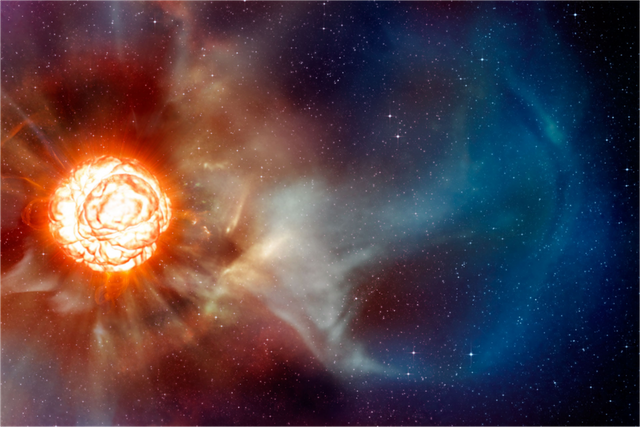
Credit;ESO/L,Casçada
148AD Alexandria, Egypt
Placing the quill carefully down on the edge of the inkwell Claudius sat back and sighed rubbing his forehead. It had been a long night observing Yad al-Jauzā and a mild headache was setting in. Being particularly hot this evening, the red star scintillated heavily from the disturbed air that the cool breeze from the Mare Nostrom assailed the hot turbid climate of the marshes that surrounded the city with.
To be honest he didnt mind the breeze, despite its effect on the viewing. It felt refreshing and the sound of the russeling palm leaves outside his veranda were soothing. Although it was late, groups of people still milled in tight knots along the avenues and navigated the busy alleyways below. Freshly rebuilt by the Emperor Hadrian, the Temple of Seraphus dominating the city from its hilltop perch, glowed comfortingly in the moonlight a short distance to the south west.
"Only a hundred or so stars left to catalogue." He muttered as if to reassure himself on the monumental endeavor he has set himself on. "Only another year or so and my Syntaxis Mathematica will be complete. "
Claudius Ptolemy's Syntaxis Mathematica went on to be one of the most important works on early mathematical astronomy earning the nickname al-Majisti meaning "the greatest" or Almagest in English translation. In it, he gives among other things a detailed description of the star Betelgeuse describing it as a 'hypòkirros' meaning ruddish red in colour. Which is interesting because just three centuries earlier astronomers would have balked if you claimed the star looked red.
Around 85BC, Sima Qian, Royal Astronomer and Grand Historian for the Chinese Han Dynasty Court wrote in his famous treatise the Shiji "historical records" that Betelgeuse, known to the Chinese as Shen Xui Shi, was absolutely yellow in colour. One might think that Sima Qian was mistaken, but he had nailed it when describing other stars to the T. So much so that his works are still considered accurate, reliable and generally unquestioned. So he was probably right when he said Betelgeuse was indeed yellow in his time.
But how could this be that Betelgeuse had completely changed its colour in just three hundred years? Scientists now believe that the famously orangey red star we know actually was solid yellow when Sima Qian had written down his observations of it. Betelgeuse had progressed from being a yellow giant to a red supergiant in that short time. An act that would usher the famous star into the final stages of its life.
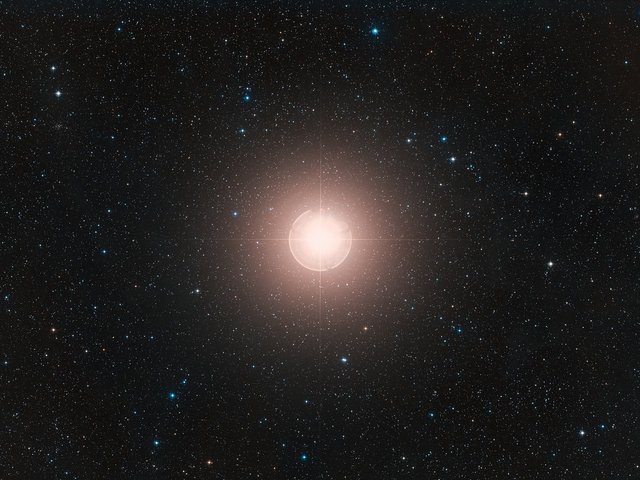
Credit:ESO/Digitized Sky Survey 2. Acknowledgment: Davide De Martin.
Betelgeuse has proven to be much more enigmatic than most presume when looking at the familiar night sky companion. Most have heard in the news that Betelgeuse is dimming. And, how that may be her final lead up to her pending supernova. However, many aren't aware that there is some high strangeness going on with the star and that with Betelgeuse not everything is adding up like it should.
Having a commanding presence in the night sky being relatively near and bright, Betelgeuse is hard to image accurately by Astronomers which leads to lots of problems. For example, astronomers aren't exactly sure how big Betelgeuse really is. Or its exact mass. They can't pin down its true distance from our solar system. Nor why its spinning unusually fast. Too fast really for what its supposed to be. Betelgeuse has an unexplained overabundance of nitrogen in its atmosphere and strange asymmetrical ejections of matter from her atmosphere. She's a "runaway star" meaning shes been kicked out of her birth place and is adrift racing across space. And even recently, it has been tentatively observed being briefly bracketed by anomolous gravitational waves, which are usually the calling sign of a major cataclysmic event.
However, a new theory about Betelgeuse's true nature has surfaced that pieces together many of her strange characteristics and frames the star in a much different light.
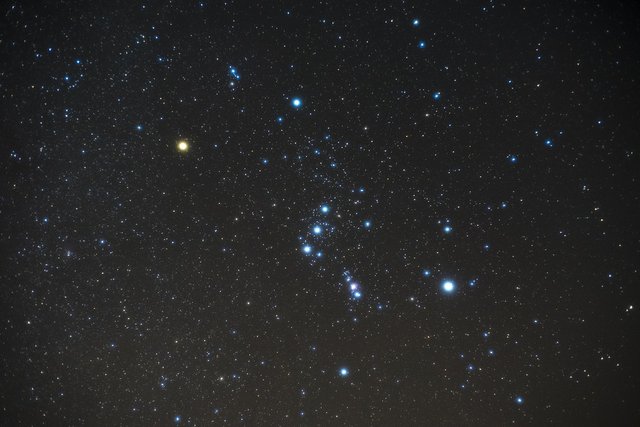
Betelgeuse bold and stunning in the upper corner of Orion
The Constellation above of the hunter Orion has been a companion to humanity since before recorded history. Cavemen carved his iconic belt into ivory. And Australian Aboriginals have mythical tales of the constellation as do many other cultures since antiquity.
Central to all of them, however, is bold orangy Betelgeuse. The Arabs named the star Yad al-Jauzā meaning "Hand of Orion." Its a bit of a funny tale on how it became to be known as Betelgeuse in modern times. Essentially it all boils down to mistranslations. The medieval Europeans botched their Latin translations of Arabic and misread the first character of Yad missing the fact that the Y has two dots underneath it, and translated it with one dot. A simple mistake, but it changed Yad To Bad.
By the Renaissance era "Bad" devolved into "Bait" which meant "house" and then further degenerated into "Bat" which roughly translates into "armpit." Technically armpit in Arabic is "Ibt," but roughly Bat al-Jauzā translates into "armpit of orion." Not a flattering name at all. Luckily its erroneous, although it stuck with the poor star for a few centuries until scholars could better research the etymology and reinstate its original meaning. None the less its obvious how the mistranslation to Bat al-Jauzā lead to our modern naming Betelgeuse.
Much is uncertain with Betelgeuse. For instance its generally believed the star is some 700 light years distant. But throughout the last 100 years the distance figures have varied wildly. In 1920 they thought maybe Betelgeuse was 180 light years away based on parallax methods of measuring distance. But by 1991 they changed their measurements to be 330 light years only to have that figure thrown out only two years later in 1993 to proclaim Betelgeuse was really closer to to 650 light years away. Of course by 1997 astronomers said "no no! Betelgeuse is 430 light years distant. We should know were the experts! " Buuuut then in 2007 they said it was more like 530 give or take 73 light years. The latest estimate says 643-700ish. Plus or minus 146 light years. There are even some folksout there that estimate as much as 1300 light years! Sheesh!
So whys Betelgeuse's distance so important. Well, without an accurate distance you cant measure reliably much of anything else about the star. Not its size, luminosity or actual mass. For astronomers thats kinda important stuff.
Anyways, it basically understood that Betelgeuse is about as wide as 10 astronomical units in diameter. An astronomical unit is the distance from Earth to the Sun. Jupiter has a figure of 5.5AU. So, if Betelgeuse were to replace our sun it would engulf all our solar system's inner planets including Earth and Mars. And, Jupiter would be skimming the stars outer atmosphere like a stone skipping across the surface of a pond.
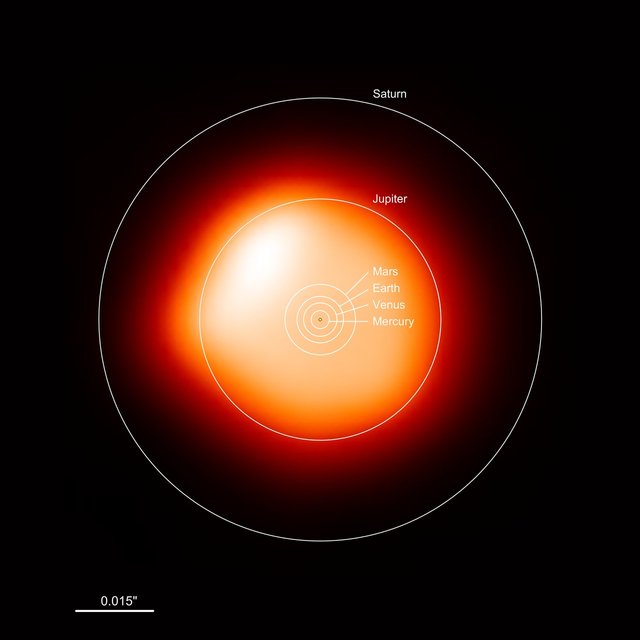
Credit:ALMA (ESO/NAOJ/NRAO)/E. O’Gorman/P. Kervella
The size of Betelgeuse if superimposed over our own solar system.
Why's it so hard to get accurate figures for Betelgeuse? Well, for starters its got a nebulous cloud surrounding it of matter its been ejecting in its final stages of life that obscures things making its true edge hard to define. And its constantly changing it actual diameter anyways in its death throws leading to a prominent variability in its brightness.
In 1836 Astronomer John Herschel documented that Betelgeuse went on a repeating cycle of growing bright and then dimming. This classifies our red friend as being whats known as a Variable Star. Essentially Betelgeuse has a six year cycle where it swells in size dimming as its surface area spreads out, casts off some of its outer atmosphere and then shrinks becoming brighter. A smaller sub cycle of brightness may exist from the sloughed off matter muting the stars brightness as it spreads out into a nebulous envelope around Betelgeuse.
This variability is mostly due to Betelgeuse being in the later stages of its life cycle. A good way to understand what a stars life cycle is and the changes many of them go through is by looking at whats known as the Hertzsprung-Russell Diagram, which you can gander at in the image below. Lately scientists think that Betelgeuse may actually be so dynamic in its life cycle that it transitions relatively rapidly back and forth between being either a blue or yellow supergiant and a red supergiant, which is how we currently observe her these days.
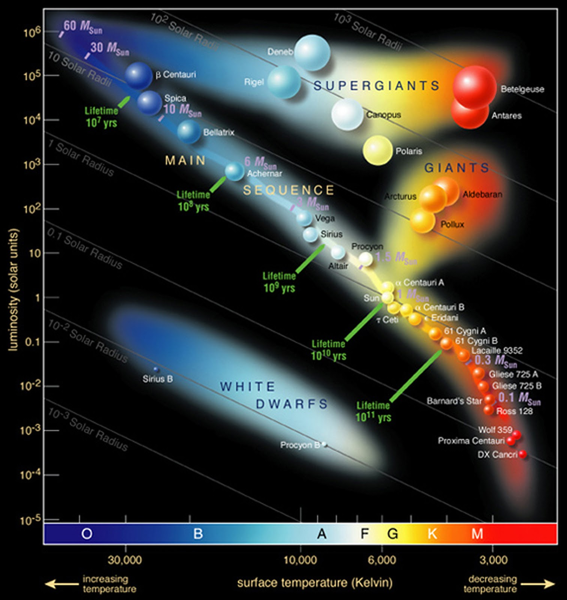
Credit; ESO
Regardless of seemingly being in her final stages, shes a young star only 8.5 to 10 million years old. The dinosaurs on earth are vastly more ancient and older than Betelgeuse. Its amazing to think that although the sun is 4.5 billion years old and will live another 5 billion, Betelgeuse has at best only 1 million years left.
Astronomers best guess as to Betelgeuse's mass is 19-20 times the mass of our sun, based on the best fit with theory and all the other sketchy observations that have been garnered from the other variables. But as usual for Betelgeuse, estimates have varied from 5 to 30 solar masses. It's important to lock down a proper determination of the stars mass if you want to predict its ultimate fate. On the low end of the scale and Betelgeuse ends up a White Dwarf. On the top end it goes out like the greatest of fireworks in a robust Type 2 Supernova. Either way the show will be entertaining on Earth, but of course it will be much more spectacular if it goes kablooey in that supernova. Plus the nebula its remnants will create will make a nice addition to an already glorious patch of the night sky.
Speaking of mass, harken back to how I wrote that Betelgeuse sheds its outer atmosphere which contributes to that circumstellar nebula that it sits in the center of. Well, its calculated that Betelgeuse sheds the equivalent of one of our suns in matter every 10,000 years these days. The nebula this action has formed has grown in dimensions to that of the size of our own solar system and is composed mostly of silicates, carbon and alumina dust. It's thought that the silicate material earth is partially made from came from a similar star doing the same sort of shedding eons ago. The old saying that we are all star dust is absolutely true.
One odd thing if you look at the imagery of this circumstellar cloud of ejected matter is that its strangely asymmetrical. Scientists are still trying to figure out as to why. The leading candidate is that Betelgeuse has asymmetrically positioned convection cells brewing inside her that periodically form giant blisters that burst and burp up massive plumes of ejected mass leading to the unusual formation.
If you scroll briefly up to the header image of this article you'll see that its an artist's depiction of one of these eruptive plumes. The star its self has a gigantic roiling bubble surfacing and a plume of dust and gas trailing away. Notice the nebulous plume has two distinct regions of colours and likely material too in the painting. Its known that this nebula has two shells of ejected matter.
The inner red one is thought to be composed of carbon and molecular water. It extends maybe 2 to 3AU from Betelgeuse's photosphere. The outer layer, depicted in blue, extends 30-40AU and has unusually high amounts of oxygen and nitrogen in ratio compared to the base of carbon that makes it up. This too is a mystery that astronomers are trying to figure out. There are theories but nothing definitive as to why.

literal imagery of Betelgeuse's nebula. Notice the irregular looking shape to it. The inner disc represents the extent of the stars photosphere and inserted inside the disc is prior imagery from a few years earlier of the plumes that form the nebula.
Betelgeuse also has a sweet looking bow shock front four light years across proceeding it. Earlier, I mentioned Betelgeuse was whats called a "runaway star" speeding adrift through space all by its lonesome. Well, its travelling at 67,000 mph or 30 kilometers a second, and as it does so, it creates this shockwave ahead of it due to solar winds. The latest accepted theory regarding the formation of this shock front was that particularly intense solar winds formed 30,000 years ago when Betelgeuse transitioned from a Blue Supergiant into its yellow red phase sending out this wave.
This shock front was only discovered in 1997 via infrared telescopes. Betelgeuse is generally too bright to get clear images of it, which makes it hard for scientists to establish accurate metrics on its variables as discussed above but also really hard to spot the shock front aside from the stars glare.
If you look at the picture the bow wave appears that its close to slamming into a wall of cosmic dust. That's because it probably is. At the currently understood rate of travel it will hit that dust wall in 5000 years from now.
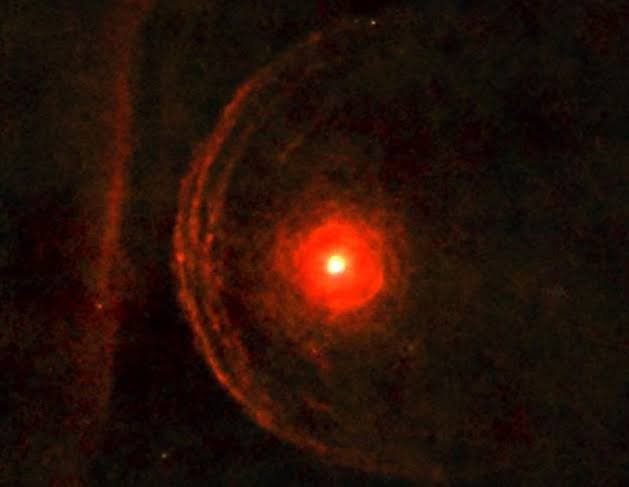
ESA/Herschel/PACS/L. Decin et al
If interested, please follow the link below to a PDF of the original scientific paper from the team that discovered Betelgeuse's bow shock. It's an extremely detailed and highly visual presentation.
https://arxiv.org/abs/1212.4870
From the relative speed and motion of Betelgeuse's movement and shock front, they've been able to tentatively deduce where the star originally came from, and they think its from a region in the Orion Constellation called the Orion OB1a Stellar Association. With a few curve balls thrown into the theory of course.
If one were to actually back track Betelgeuse's current vector it leads to a barren and isolated region of space 290 parsecs or 945 light years outside the galactic plane. A far away and unlikely place for Betelgeuse to form. If the stars current course has not changed somewhere in the past, then Betelgeuse literally has come from out of nowhere.
However, to account for this, its been proposed that long ago some sort of supernova or similar event must have knocked Betelgeuse off its original course. In scanning the skies the only plausible location within a certain radius that could have birthed Betelgeuse would be the Orion OB1a Stellar Association. A cluster of stars located in the Orion Constellation. The truth is they really dont know for sure where Betelgeuse came from.
Surrounded by thousands of other recently formed low mass stars, OB1a is a good place for a star to ride out its infancy. Or so it would seem. If Betelgeuse really did come from there, then it turns out the Orion OB1a Stellar Association didn't exactly want to be associated with Betelgeuse and via combined gravitational forces kicked the poor star out into deep space exile and to eventually get battered by a nearby presumed supernova.
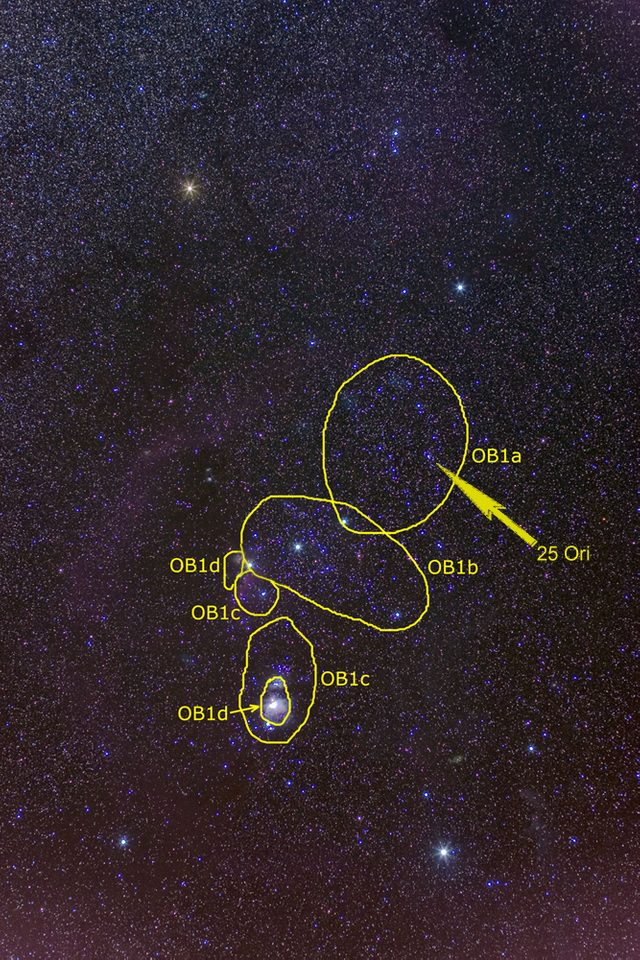
Credit; Mouser, Roberto Mura derivative work: Sadalsuud
In January 2020 a pair of brief bursts of gravitational waves were detected by the LIGO array bracketing Betelgeuse. This is peculiar. Gravity waves are usually seen when immensely catastrophic incidents occure like as seen recently when two black holes collided.
Initially, very briefly, some thought its was possible the waves might have been an indicator that Betelgeuse had just gone supernova. But the cascade of neutrinos bombarding sensors as observed with supernovas didnt occur and Betelgeuse is still there burning in the sky tonight for all to see. So we know that whatever caused these waves wasn't from Betelgeuse going supernova. In actuality they probably arent even associated with Betelgeuse directly.
There is the chance that the gravity waves observed were really just a set of false positives. All be it small, the array does has an error rate equivalent to one false positive every 25 years. Nonetheless, their source still remains a mystery and if real point to something very strange going on.
Betelgeuse has one last very curious enigma that confounds astrophysicists and leads to a very interesting theory about Betelgeuse's true nature. Betelgeuse spins far too fast than normal for any star like it. Rotating at 15 Kilometers a second or 33,500 mph, the stars spin is several times faster than it should be. Scientists cant figure out exactly Betelgeuse is getting this tremendous amount of extra angular momentum from. Well, one team of scientists have recently come up with an intriguing idea as to how.
J. Craig Wheeler an astrophysicist and Regent Professor of Astronomy at
The University of Texas at Austin, is a leading expert on supernovas who has been spending a good deal of time thinking about the enigma that Betelgeuse's unusually fast rotational speed presents. In 2016, Wheeler and his team took all the variables known about Betelgeuse and entered them into a computer program to attempt to solve the mystery. The conclusion the computer came to as most likely paints a captivating picture.
Like a Leviathan gliding stealthily under the waves, churning up the sea, Betelgeuse has the partialy digested core of a star once the size of our sun orbiting and hidden just under her surface.
Before its ejection into dep space, Betelgeuse is thought to come from a region of space that should in theory yield many binary star systems. So its very plausible that Betelgeuse formed as one too.
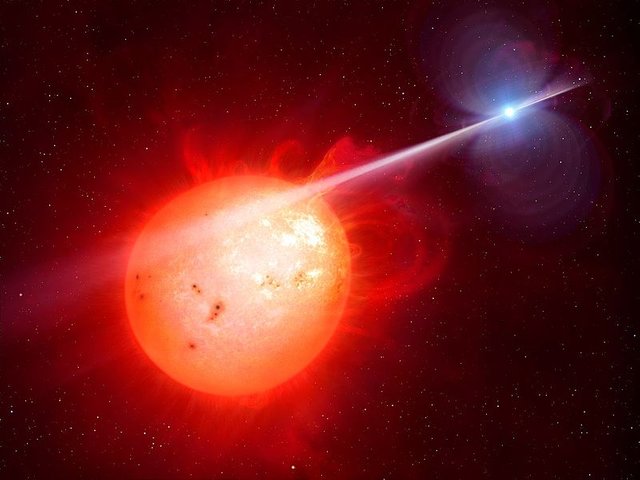
Credit: M. Garlick/University of Warwick/ESO
An artists impression of a binary star. Imagine the star in red swelling up so massively in size that it envelops the orbiting star in blue. This is what Wheeler and his team has proposed is going on with Betelgeuse
As the star moved on from its main sequence on the Hertzsprung scale to it's later stages it began to cool and swell in size on its evolution to becoming a red giant. Eventually, Betelgeuse expanded past the orbit of its much smaller companion and enveloped it entirely. The companion, not yet consumed by the carbon burning or perhaps, if in very late stages, silicon burning inner core of Betelgeuse slowly dissolves and coalesces adding to the red giant.
If this is the case, besides explaining Betelgeuse's anomolous high rate of spin, it well explains the perturbations to Betelgeuse's atmosphere as the half digested companion stirs the various inner layers of the star. It also explains the over abundance of nitrogen being ejected into the dusty cloud that surrounds it.
Furthermore, Betelgeuse's " bow shock front" may not be entirely due to stellar radiation but also largely from during the epoch of merging between these two stars where symmetrical ejections of matter has occured. Indeed simulations show that the nearly spherical shock fronts are too symmetrical to be explained by solar winds.
The papers presented by the research team can be found in this PDF link below.
https://arxiv.org/abs/1611.08031
The follow-up paper by the same team addressing how best to catalogue and describe Betelgeuse's likely condition and stage of stellar evolution can be found at this link below.
https://arxiv.org/abs/1805.10347
If Wheeler's theory proves true then that means Betelgeuse isn't likely to be going supernova anytime soon....in fact it just refueled.

Credit; ESO/B. Tafreshi (twanight.org)
Mighty Betelgeuse, far right, dominating the skyline at the Atacama Large Millimeter Array
Thank you for taking the time to read my post on the enigmatic star Betelgeuse. I hope it was an interesting read and gave you a moment of respite from daily life. I love any and all comments and respond to them all, so please feel free to post any.
Lastly I'd like to thank my wonderful fiance @kaelci, without whome I wouldnt have found the courage to post on Steem.
If you enjoyed my astronomy post you can see the rest of my ongoing series at the below links.
Thanks again for reading,
Steemydave
My Astronomy Series
The Hunter and the boy
https://steempeak.com/astronomy/@steemydave/the-hunter-and-the-boy
A Surreal Nebular Safari in the Southern Skies
https://steempeak.com/astronomy/@steemydave/a-surreal-nebular-safari-in-the-southern-skies
The Mystery of the Celestial Guest
https://steempeak.com/astronomy/@steemydave/the-mystery-of-the-celestial-guest
Credits
Pixabay.com
https://www.eso.org/public/images/eso0927a/
https://it.m.wikipedia.org/wiki/Betelgeuse
https://www.eso.org/public/images/eso0728c/
Credit ESO - per CC4 rules, no changes made.
https://en.m.wikipedia.org/wiki/Orion_OB1_Association
Credit -per cc-SA3 rules, no changes made.
http://www.esa.int/Science_Exploration/Space_Science/Betelgeuse_braces_for_a_collision
https://www.eso.org/public/images/eso0927e/
https://www.eso.org/public/images/potw1726b/
https://www.eso.org/public/images/potw1513a/
Thank you for posting @steemydave . No doubt you have seen the recent SPHERE image of Betelgeuse which shows what might be a large cloud of dust obscuring much of the star and reducing it's current brightness to a third of it's normal brightness. The constellation of Orion of which Betelgeuse is part of looks strange as result.
Hey Terry! Very honored to have you stop by my post and comment. I have seen the latests SPHERE imagery and found that dust cloud worth looking at. I think Betelgeuse's current dimming is a combination of that dust cloud and a rather large, powerful and dominant convection cell thats taking its time shuttling the energy and luminosity to Betelgeuse's surface. I dont think its the core getting ready to go. I think Betelgeuse has a good amount of time left before it fuses silicon especially if it actually turns out to be feeding off a companion like Wheeler's team believes. He has a new report coming out on it pretty soon. Will be interesting to see whats in it.
Anyways, glad you stopped by and I thank you.
It was a great read. Thanks a lot.
Are you an astronomer?
Hi ecotone! Glad you enjoyed the post. I am not a professional astronomer. Just somebody who loves astronomy and science. Aerospace and horticulture are two other big passions of mine. And I enjoy steem too!
Cool photos! I like them :-D
Keep things up!
Cheers,
ATMODEPTH